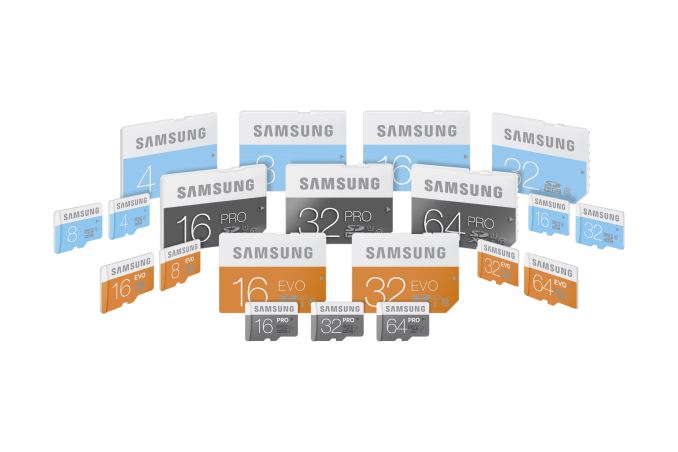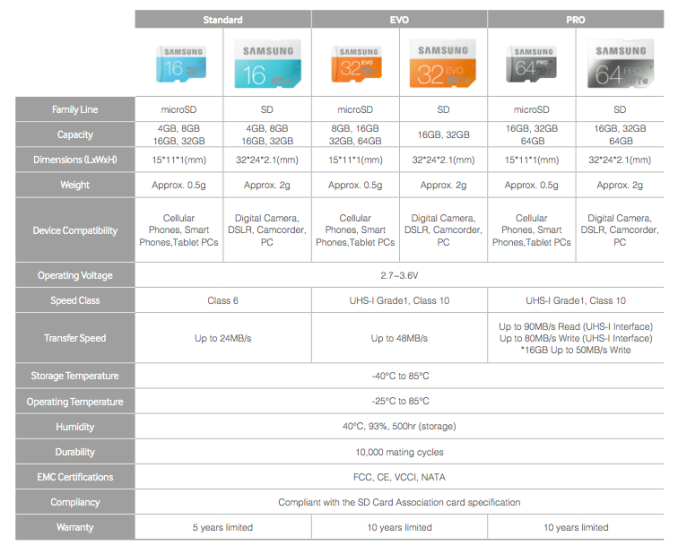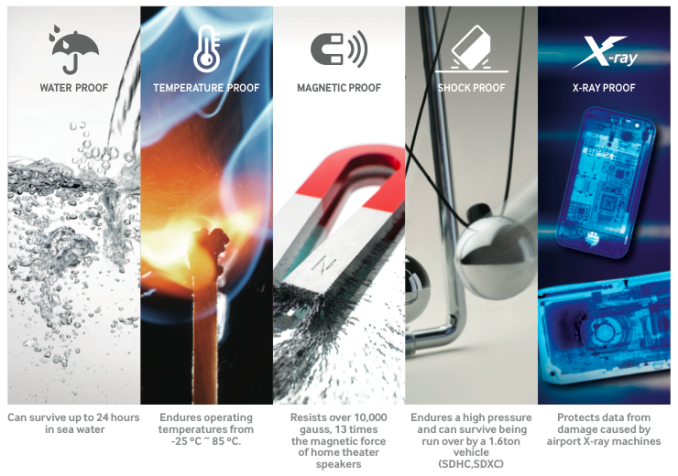Samsung Releases Standard, EVO and PRO SD Cards
by Kristian Vättö on April 7, 2014 10:05 AM EST
With the rapid decrease of NAND prices in the last few years, the SD card market has more or less become a commodity with very little differentiation. We don't typically note minor product releases but we'll make an exception here given that this one is a bit more significant than the average.
Samsung is revamping their whole SD card lineup at once by simplifying it into three product series: Standard, EVO and the PRO. Those who are familiar with Samsung's SSDs notice that the EVO and PRO brands are adopted from the 840 SSD series, which makes sense given Samsung's success in the SSD space and the brand they've been able to build with the 840 EVO and Pro.
Samsung's goal with the branding is to make it as easy as possible for the customer to select an SD card that fits their needs because oftentimes SD cards are marketed using the class system (like class 10), which may not tell much to an average SD card shopper. Electronics stores tend to have isles of SD cards available and differentiating in that space is extremely hard, so Samsung hopes that its simple branding will help to boost sales. Each brand also has a unique color (turquoise for Standard, orange for EVO and black for PRO) that aims to simplify branding even further and to allure customers (we all like vibrant colors, don't we?).

At the low level these are all MLC NAND designs but with varying quality of NAND being used. In fact only a small portion of the NAND meets the requirements for SSDs, the rest of the NAND is used in products where endurance and performance aren't as critical (such as USB drives, SD cards, eMMC...).
Update: As some of you speculated in the comments, the Standard and EVO models do in fact use TLC NAND, while MLC NAND is only used in the PRO model. The info we got from Samsung during the initial briefing was incorrect and we apologize for the confusion.
All in all, the SD card market as a whole is quite uninteresting. When you can get a decent SD card for a tenner or two, it's logical that not much time is spent on the purchase decision or research. Simple branding can help with that and the high-end niche for the PRO model does exist, but I still believe that the average buyer will just get the cheapest card available or the one that is recommended by the sales rep.











46 Comments
View All Comments
hojnikb - Monday, April 7, 2014 - link
It's interesting, that they are using MLC across all the range. They could probobly easily use TLC on lower end.Also lack of 128GB cards is kinda dissapointing, give competition already has cards so large.
Rocket321 - Monday, April 7, 2014 - link
On the TLC point, Transcend advertises their "high-end" SDcard models as MLC (a selling point), I'd be surprised if the standard models here are using MLC.Kristian Vättö - Monday, April 7, 2014 - link
Samsung told me that all models are using MLC, even the Standard one.dylan522p - Monday, April 7, 2014 - link
Because their mobile side is so truthful......Kristian Vättö - Tuesday, April 8, 2014 - link
I just got a correction from Samsung and as you guys suspected, the Standard and EVO do indeed use TLC NAND. Sorry for the confusion, the initial information we received from Samsung was incorrect but it's corrected now.Morawka - Monday, April 7, 2014 - link
is TLC support common on eMMC Storage controllers? If it's only on a few controllers then its not practical.Guspaz - Monday, April 7, 2014 - link
A strange limitation, that the full-sized EVO card is limited to 32GB, while the micro-sized card is 64GB.hojnikb - Monday, April 7, 2014 - link
Could be a typo or just a sneaky way of forcing users to buy the PRO version :)fluxtatic - Thursday, April 10, 2014 - link
Or just that micro SD is more flexible. Toss in a $.05 adapter and lo and behold, a standard SD card.jgstew - Monday, April 7, 2014 - link
I like to have all the performance I can get for my DSLR. I'd love to see the Samsung PRO SD cards benchmarked against the Sandisk Extreme Pro SD cards: http://www.amazon.com/SanDisk-Extreme-Class-Memory...